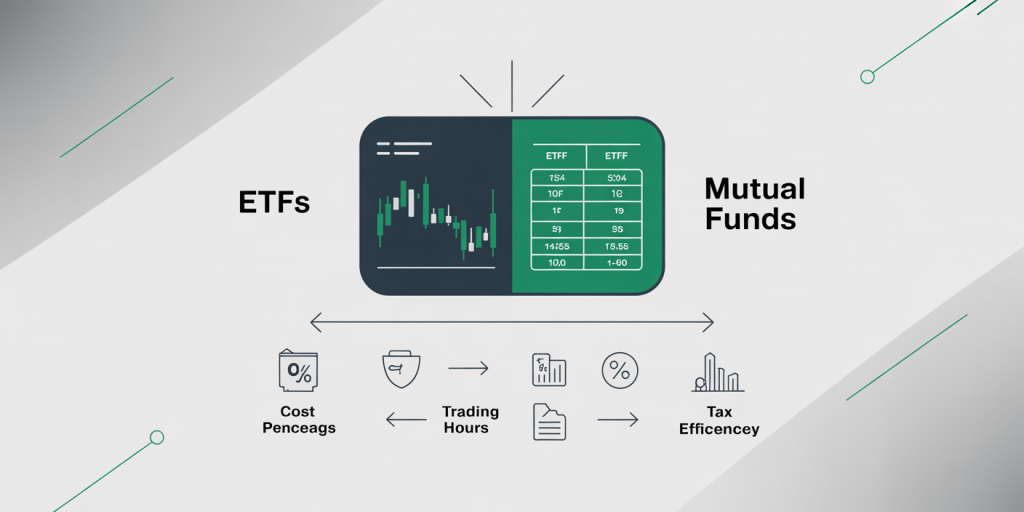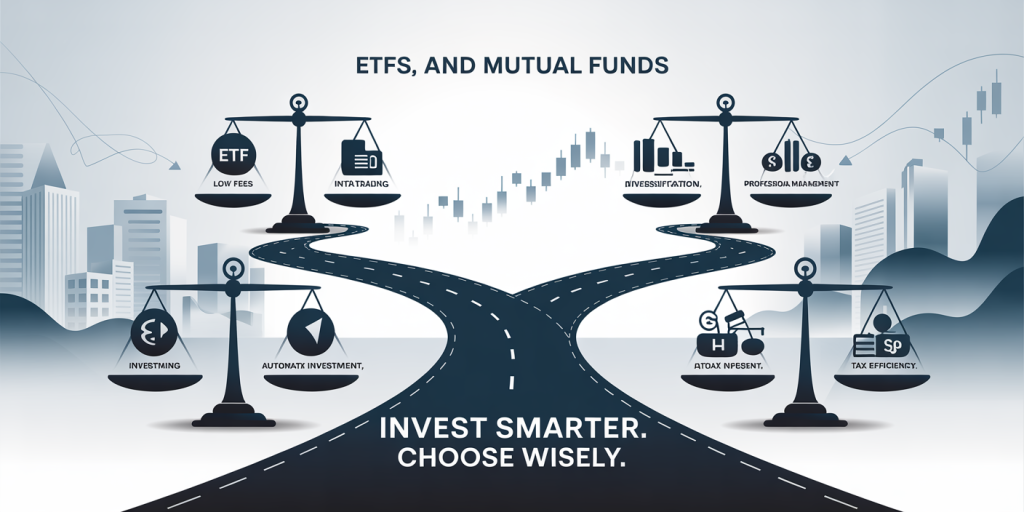Navigating the world of investing presents new challenges for beginners, especially when choosing between popular investment vehicles like Exchange-Traded Funds (ETFs) and Mutual Funds. Both offer diversified exposure across various assets, making them attractive for novice investors seeking to build a portfolio with reduced risk compared to individual stocks. However, differences in structure, fees, tax implications, and trading flexibility make the decision less straightforward. This article explores ETFs and mutual funds in detail, providing practical examples and data-driven insights to help beginners make informed choices.

Understanding ETFs and Mutual Funds
Before diving into a comparative analysis, it’s essential to understand what ETFs and mutual funds actually are. Exchange-Traded Funds (ETFs) are investment funds that trade on stock exchanges similarly to individual stocks. They hold a basket of assets such as shares, bonds, or commodities designed to track an index, sector, or theme. For example, the SPDR S&P 500 ETF (ticker: SPY) tracks the S&P 500 index and trades like a normal stock throughout the trading day.
Mutual funds, on the other hand, pool money from multiple investors to purchase a diversified portfolio of stocks, bonds, or other securities managed by professional fund managers. Unlike ETFs, mutual funds are priced at the end of the trading day, based on their net asset value (NAV). A classic example is the Vanguard 500 Index Fund Investor Shares (VFIAX), replicating the performance of the S&P 500.
Both ETFs and mutual funds aim to provide diversification and professional management but differ significantly in how investors buy, sell, and are charged for holding these assets.

Fee Structures and Cost Efficiency
One of the most critical factors influencing beginners’ choices is the cost associated with investing in ETFs versus mutual funds. Generally, ETFs tend to be more cost-efficient than mutual funds, especially actively managed mutual funds.
ETFs typically have lower expense ratios because many track passive indexes, which require less active management. According to Morningstar’s 2023 data, the average expense ratio for equity ETFs was 0.23%, compared to 0.77% for actively managed equity mutual funds. For instance, the Schwab U.S. Broad Market ETF (SCHB) charges an expense ratio of just 0.03%, making it a bargain for cost-conscious investors.
Mutual funds often come with additional fees such as front-end or back-end loads, which are sales commissions paid when buying or redeeming shares respectively. Additionally, some mutual funds impose redemption fees to discourage short-term trading. ETFs avoid those issues since they trade on exchanges with commission-free trading now widely available through most brokerages, including platforms like Robinhood and Fidelity.
Here’s a comparative table outlining basic fee differences:
| Fee Type | ETFs | Mutual Funds |
|---|---|---|
| Expense Ratios | 0.03% – 0.50% (average) | 0.50% – 1.50% (average) |
| Sales Loads | None | Front-end/Back-end loads |
| Trading Commissions | Usually none or low | Typically none |
| Redemption Fees | None | Sometimes applied |
For beginners wary of high fees eating into returns, ETFs offer a clear edge, especially passive ETFs with minimal operational costs.
Trading Flexibility and Accessibility
The ability to buy and sell at any time during the market hours is one of the major advantages ETFs have over mutual funds. ETFs trade like stocks on exchanges, allowing investors to buy, sell, short, or use limit orders throughout the day. This intraday liquidity offers price transparency and flexibility.
Consider a beginner investor worried about market volatility. Using ETFs, they can buy a broad market index ETF like the Vanguard Total Stock Market ETF (VTI) at market open at 9:30 a.m. and sell later that day if needed at a more favorable price. Mutual funds operate differently. Orders placed during trading hours are executed after the market closes, using the day’s closing NAV. This delay could mean less control over exact buying or selling prices, especially in volatile markets.
Furthermore, ETFs allow investing in fractional shares through new brokerage offerings, widening accessibility even with small amounts of capital. Mutual funds usually have minimum investment requirements, often ranging from $500 to $3,000 or more, which could be a barrier for new investors starting with limited funds.
However, mutual funds excel in automatic investments and dividend reinvestments. Many mutual funds allow fixed-dollar automatic monthly contributions without transaction fees, which is ideal for beginners following a dollar-cost averaging strategy.
| Feature | ETFs | Mutual Funds |
|---|---|---|
| Trading Hours | Intraday, market hours | End-of-day NAV pricing |
| Minimum Initial Investment | Often none or very low | $500 – $3,000+ |
| Fractional Shares | Increasingly available | Generally not available |
| Automatic Investments | Limited | Widely offered |
Thus, the choice depends on an investor’s preference for trading flexibility versus systematic investing.
Tax Efficiency and Implications
Taxes significantly impact net investment returns, especially for taxable accounts held outside of retirement plans. ETFs generally have an edge in tax efficiency compared to mutual funds.
ETFs use an “in-kind” creation/redemption mechanism where shares are swapped between authorized participants without triggering capital gains distributions. This design allows ETFs to limit the internal capital gains passed to investors. According to a study by Vanguard in 2022, tax costs for ETFs were about half the cost borne by comparable mutual funds.
Mutual funds, especially actively managed ones with frequent buying and selling within the fund, tend to distribute capital gains to shareholders annually. For example, in 2023, many actively managed funds distributed capital gains ranging from 5% to over 20% of portfolio value, creating unexpected tax bills for investors.
That said, in tax-advantaged retirement accounts like IRAs or 401Ks, this tax efficiency is less relevant. However, for beginners investing in taxable brokerage accounts, ETFs often lead to more favorable after-tax returns.
Consider the case of an ETF investor and a mutual fund investor both holding $10,000 in similar index funds over a tax year. The ETF owner may receive little to no capital gains distribution, whereas the mutual fund owner might have to pay a few hundred dollars in capital gains taxes, reducing overall investment growth.
Performance and Diversification Considerations
Another vital factor to consider for beginners is how ETFs and mutual funds perform and their diversification capabilities. Generally, both instruments can offer similar diversification benefits if they track the same index or asset class.
A beginner investing in a broad-market S&P 500 index ETF or mutual fund can expect nearly identical performance over long periods, excluding fees and taxes. For example, Vanguard’s VFIAX (a mutual fund) and VOO (an ETF) both track the S&P 500 and historically have shown negligible performance differences. Morningstar data shows their annualized returns since inception are within a few basis points of each other.
However, actively managed mutual funds might outperform or underperform ETFs or index funds, but evidence suggests only a small fraction of these funds beat their benchmarks consistently. The SPIVA (S&P Indices Versus Active) report reveals that over a 10-year period, around 85% of actively managed U.S. equity funds underperformed passive benchmarks.
Beginners typically benefit more from low-cost, diversified index funds or ETFs because of simpler structures and predictable performance. ETFs also offer exposure to niche sectors, commodities, or international markets with a single trade.
| Aspect | ETFs | Mutual Funds |
|---|---|---|
| Diversification | Varies by fund type | Varies by fund type |
| Potential for Outperformance | Limited in passive ETFs | Higher for actively managed |
| Historical Returns | Similar to index funds | Varied widely |
For example, an investor interested in green energy can purchase the iShares Global Clean Energy ETF (ICLN) easily, whereas a similar mutual fund could have higher costs and management fees.
Emerging Trends and What the Future Holds
The investment landscape continues to evolve, impacting how ETFs and mutual funds cater to beginner investors. One growing trend is the rise of thematic and smart beta ETFs offering innovative ways to invest based on factors like ESG (Environmental, Social, Governance), dividend yield, or momentum strategies. These specialized ETFs attract investors seeking tailored portfolio construction without paying high mutual fund fees.

Additionally, the proliferation of commission-free trading apps and fractional shares has made ETFs even more accessible to the masses. According to a 2023 report by Statista, approximately 70% of retail brokerages worldwide now offer commission-free ETF trading, a stark contrast to a decade ago.
Mutual funds, while slower to adapt, are also innovating by reducing minimum investments and incorporating digital platforms to attract millennials and Gen Z investors. Robo-advisors increasingly use combinations of ETFs and mutual funds to create diversified portfolios suited to an individual’s risk tolerance and financial goals.
Regulatory changes might also impact tax treatment and fee structures in the future. The push for greater transparency and lower fees may further narrow the cost gap between the two investment vehicles.
In summary, for beginners, ETFs are becoming more attractive projects due to cost efficiency, tax benefits, and flexibility, while mutual funds maintain strengths in systematic investing and retirement accounts.
Final Thoughts: Choosing What Fits Your Goals
Beginners deciding between ETFs and mutual funds should carefully assess their personal financial goals, investment horizon, tax status, and comfort with trading flexibility. ETFs tend to be the better choice for those valuing low costs, tax efficiency, and the ability to trade intraday. In contrast, mutual funds might suit investors who prefer automated investing or access to actively managed strategies without worrying about intraday price movements.
By gaining a clear understanding of each fund type’s mechanics, fees, and practical examples, novice investors can build sturdy and cost-effective portfolios that serve them well over time. As the investing environment evolves, staying informed and adaptable will maximize the benefits from both ETFs and mutual funds in a beginner’s financial journey.

Deixe um comentário